TAKEAWAY: Reporting from Hong Kong this week again. It ia an across the platforms series of discussions and presentations at the South China Morning Post ALSO: See the Page 1 for Sunday’s The Washington Post, which premiered a series of changes yesterday, including new style for promos on A1, as well as Sunday Style (now a tabloid), new Arts, Kids Post, among others.

A storytelling project across the platforms
There are two cities that do this to me: that first impression when you first see their skylines——New York City and Hong Kong.
I arrived here mid morning Sunday, and, of course, it was grand to see the sun and put the top coat away. My last stop was Oslo, and the last view of that glorious nordic city was as the plane took off and I saw the perfect winter picture postcard. The trees, the ground, the roofs all white as if someone had taken a fine brush to make sure not one spot was missed.
Land in Hong Kong and one sees green again (only a few days, as my next stop from here will be Moscow and hello to deep winter again!).
The next five days here are typical of what is happening in newsrooms across the world now.
My work with the South China Morning Post moves across the platforms, and that they way the discussions go. We finalize prototypes of the printed edition. The SCMP is still a broadsheet but we are rethinking how it presents stories. In addition, as we work across the other platforms——online and the next version of the iPad app——the discussions center on storytelling first, the flow of information, and how we can use what we know about information architecture from the digital media, to transfer some of that knowledge to an easier navigate printed newspaper.
Eliminate those barriers
A media reporter interviewing me for an upcoming piece asked a question that many of you may also have:
“Tell me, Mario, you have been known for your work with print for decades. Suddenly you are very involved with iPad apps, for example. Has this changed your mode of operations in how you plan and carry out your work?”
Obviously, I don’t do today what I did five years ago. Things have changed dramatically, but, I insist, one thing remains the same: we must push the good stories, the great photos, the graphics that explain. That is exactly what we have been teaching from day one, except that in those early American Press Institute and Poynter Institute seminars of the late 1970s and 1980s, the emphasis was on how those components landed on a page. The good story or good photo continue to be that, but we now must discuss how the other platforms can give those stories, photos and graphics longer legs.
I am not in favor of departmentalizing my meetings so that the print people come at 10 and the digital editors after lunch. Part of the dynamics for progress today require that those separations disappear.
I am helping with the rethinking of a title, a brand, if you wish, and exploring possibilities across its many platforms.
I forgot to tell the interviewer that, indeed, this is more work!
Come back to TheMarioBlog for more reports of our progress, plus interviews with the editors and managers that are making it happen here in Hong Kong.
TheMarioBlog post #698

Third update, Sunday, Jan. 23, 13:06 Hong Kong time
TAKEAWAY: This Sunday readers of The Washington Post will see a revamped edition of their newspaper, including the introduction of a new, slick Sunday Style section in tabloid format, rethought Arts section, Kids Post and newly redesigned navigation units on A1. We describe our involvement in the process.
A new Sunday Post starting January 23
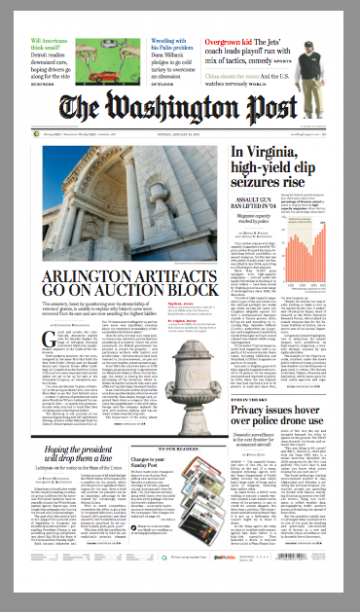
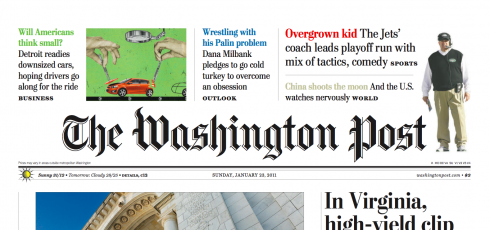
Here is the front page of Sunday’s The Washington Post, with new A1 promos at top; page designed by Jon A. Wile, Senior News Designer
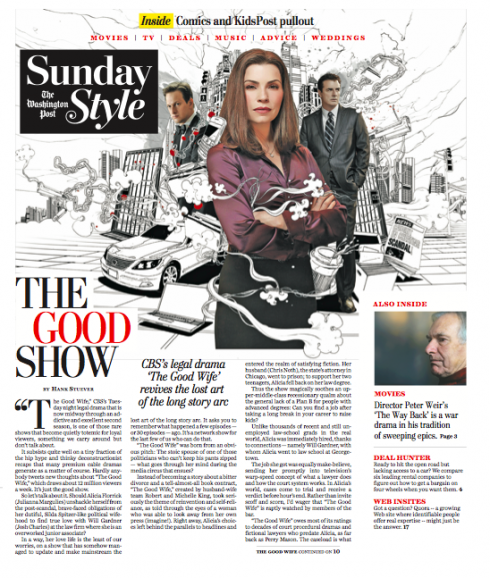
First cover of the new Sunday Style section as it will appear Sunday
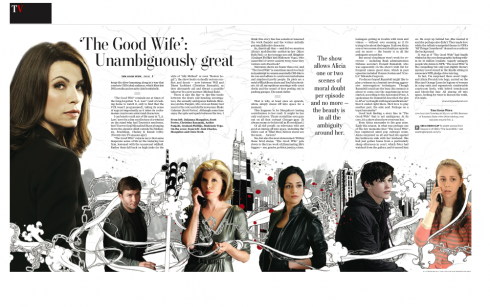
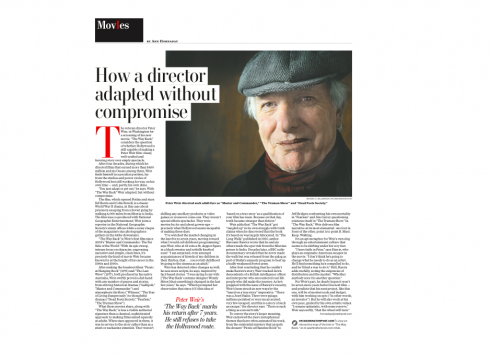

Inside pages of the new Sunday Style section
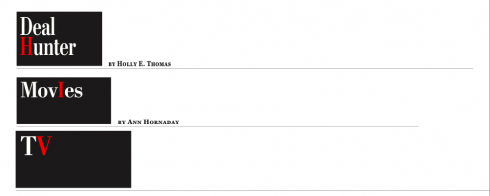
Our concept for headers for inside pagers borrows the “pill box” rectangle used on the front page logo for the section. The one letter of the logo in red erupts from the black background of the box.

Here’s prototype of how the new front page promos for Page One will appear at The Washington Post starting Sunday: a combination of free form units with soft pastel colors
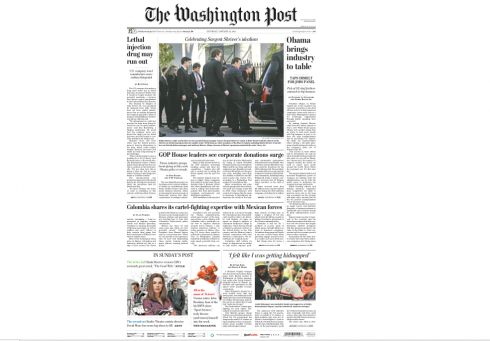

Here is a “mosaic” approach to the navigation, as it appears on the The Washington Post Saturday, calling attention to all the special content coming in the Sunday Post; many of the new offerings will already be inserted in the Saturday editions, allowing readers more time to go through them leisurely
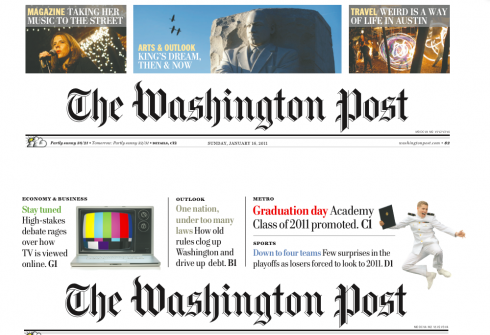
This image shows how Sunday Post front page promos looked until last Sunday (top), and the new approach, more open, less boxy and with softer use of colors.
Don’t know why, but everytime I am working on a project anywhere in the planet, I always imagine a couple of people who would be consuming that product: newspaper, magazine, app, or whatever platform. It helps me with a sense of “localness” and allows me to focus on making the product suitable to a specific audience. We all know that the product that is for everyone ends up being for no one.
And so, when Marcus Brauchli, executive editor of The Washington Post, and Raju Narisetti, managing editor, invited me to come to DC and work with them and their team on the creation of a new Sunday Style section for the Post, my immediate reaction was one that included a cozy Sunday morning somewhere in a corner of the living quarters of the White House, with The Obamas enjoying their Sunday Post, including the new Style section.
Who knows? Maybe this will really happen and we will hear their reactions. There is something in the new Sunday Post for every member of the Obama family, including their young daughters as well as their in-residence maternal grandmother!
What will they see?
First, the Sunday Style, in tabloid format, is part of a major series of great changes
and offerings coming to readers of The Washington Post Sunday, January 23.
Among the changes coming to the Post this Sunday:
*Expanded coverage of arts and popular culture creating separate Arts and Sunday Style sections, adding new features and columns and delivering feature sections on Saturday to give busy readers more time to enjoy their Sunday paper.
*Sunday Style will be a new tabloid-size section focused on popular culture, featuring coverage of movie, television and music by Hank Stuever, Ann Hornaday and other award-winning Post journalists. The new section will also have stories on fashion, shopping deals, the latest trends on the Internet and the week’s most interesting photos from the Washington-area social scene. The popular Style Invitational and Celebritology will move from Saturday to Sunday Style, where they will appear with pop-culture book reviews, weddings coverage in On Love and well-read advice columns by Carolyn Hax and Amy Dickinson.
*The expanded Arts section will showcase The Post’s world-class coverage of theater, opera, art, dance, classical music, architecture and museums with stories by renowned critics Sarah Kaufman, Philip Kennicott, Anne Midgette and Peter Marks. The Arts section will range from internationally significant openings and exhibits to the latest goings-on in Washington-area institutions, creating an expanded community for art-lovers in a city that treasures the arts.
*Sunday will also include a brand-new KidsPost tabloid, extending a popular feature of the daily paper to the Sunday Post as well. The new section will offer stories, games, puzzles and jokes for children and give young readers a separate, pull-out section of their own. KidsPost will come wrapped around the Sunday color comics.
The visual concept for Sunday Style
As soon as I arrived at The Washington Post, my task was to work closely with the talented design director, Janet Michaud, testing various ideas for Sunday Style.
First stop: the creation of a logo. It should say Sunday Style, but it must also carry Post somewhere in there. From the start, we decided that the logo should follow a “pill box” format, as to make it more economical. After all, this is a tabloid format, so the size of every element on that precious cover counts.
Second stop, secure the services of Jim Parkinson to help us with the final logo concept for Sunday Style. Parkinson did his usual magic and the logo for Sunday Style is crisp, attractive, elegant and, although new, has the familiarity that makes it a first cousin of everything else that is already in the Post.
Third: Janet and I spent hours conceptualizing the cover. We knew that we had to have text on the cover, and not just a headline and a summary, but a big chunk of the story there. The task here was to make text, photos, logos and navigational units come together as ONE. To that effect, no column rules, no boxes. My recent work in Europe has showed me that a free form style of design brings cohesiveness to a page, especially the small canvas of a tabloid, while incorporating areas of white space. Readers do not require boxes and rules to create separations. The storytelling process flows more naturally in an open environment.
In addition, we tried the use of columns of text touching or protruding into photos sometimes, a way of creating associations.
Fourth, we tackled the inside pages, creating a simple square “pill box” unit for the top of the page headers. Simple and small, allowing for air at the top of every page.
The rest was in the hands of Kevin Sullivan, Post’s features editor, and his team, creating stories to populate the canvas Janet and I had created.
“At a time when there is a lot more talk of apps and there are many more digital versions of newspapers, the Sunday changes are also a strong signal to our readers that the Post will continue to invest in its print offerings, which have a large, loyal readership,” says Post Managing Editor Narisetti. “For this investment—in new pages, new content—to pay off, we really needed a fresh design that engages our busy readers within the overall Post look and feel that they have come to love. And that is where your ideas and work was invaluable, Mario.”
New navigation at the top of Page One
Working with news designer Greg Manifold, we designed a new set of Page One navigations, incorporating subtle pastel colors, getting rid of boxes and opening the area at the top of the page, above The Washington Post logo, the same way that we had done for the cover of Style.
A similar style of navigation, but more in mosaic style, appears on the Saturday edition of the Post to promote the Sunday content.
Part of our work has been to standardize navigation throughout the Post.
It should all make the readers’ journey through their Sunday Post all the more enjoyable. Now, will we ever know what those first citizens of Washington, The Obamas, think about these great Post offerings on Sunday?
TheMarioBlog post #697